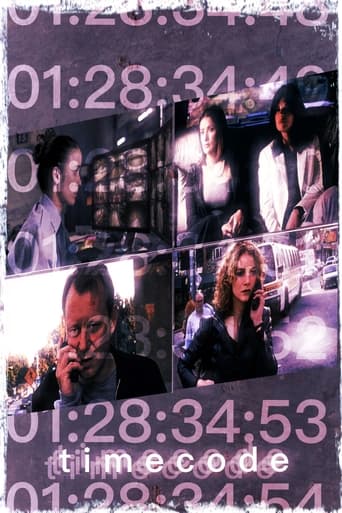jfarms1956
I give this movie a 2 out of 10. I believe that the four vignettes going on at the same time is way, way way too confusing. I saw this movie on TV and not on DVD which could explain the differences in the reviews. It was way too much work to sit and enjoy the movie. Not only were there four different vignettes, the sound kept going off and on through each of the four vignettes so that even though the video was continuous the sound was choppy and it was difficult to get into the cohesiveness of the movie(s).This is definitely a movie for those 20 and above and for those below the age of 70 who would enjoy a more cohesive movie. There is no snack time during this movie since it will take your complete and total focus to understand all that is going on. Way too much work for me. I like to sit back and enjoy the story (singular) on screen and not have to try and concentrate on four different vignettes with intermittent sound. This movie is only good to figure out if you enjoy multiple movies at the same time. It is almost a waste of time to see.
mdarmocida
OMG this was an absolutely awful movie! The movie puts you in the wrong mood from the very beginning when they start with the upper right camera but keep rolling credits and playing intro music in the other three frames (making it nearly impossible to understand the upper right frame). Then they gradually bring in the other frames one at a time. Once all four frames are on-board you're thinking the movie will pick up and the plot will take shape - never happens. If you're going to do something this daring you should at least have a good story with which to do it. However, this is without a doubt the worst movie I've ever seen (and I've seen some pretty bad movies). Even if the same story was a single screen movie it would also be the worst movie I've ever seen - again the story sucked. The story goes nowhere and there's never a payoff. It's like the producers put this movie together simply for the sake of syncing four frames in a time-code without any concern for the movie being good; either that or they spent so much money on the technical challenge and the brand name actors that they didn't pay for a writer and had a retarded monkey write the script for them.
Lechuguilla
Filmed in one long, unbroken take, with lots of improvised acting and dialogue, this highly experimental film by director Mike Figgis presents a screen that splits the action into four quadrants, formed by the intersection of the X and Y geometric axes. The quadruplicate visuals take some "time", pardon the pun, to get use to. But gradually, we settle into the story, as characters move out of one screen and into another.Figgis manipulates the sound to highlight which of the four segments we are to focus on. But I found this approach doesn't always work, as sound from other segments bleed into the main action segment. Further, the film's score is too loud, which compounds the problem. Because of the complex nature of the visuals and sound, "Timecode", obviously, is not a film for viewers who wish to turn off their brains.What I really liked about the four screen approach is that it conveys clearly the idea that an individual out of sight from others can have an impact on the overall trend of group thinking and behavior. Our words and actions thus affect others more than we realize. This impact doesn't come through as well in standard filming because the plot action takes place sequentially rather than concurrently.Although this is a technique film, it's the story and the characters that I reacted to most forcefully. The setting is Hollywood. The characters are all in the film business. The plot has people preparing for auditions, executives discussing scripts, people walking through offices carrying papers, and one character, Lauren (Jeanne Tripplehorn), spending most of the film sitting in a limousine, chain smoking, and listening to a Walkman.None of these people are appealing or sympathetic. They all come across as self-absorbed, desperate, two-faced, shallow, and pretentious. The irony here is that while the story is fictional, the plot and characters represent fairly accurately what does, in real-life, go on in Tinseltown.What would have been more compelling is a documentary approach, using real people in the film business, as they spend a typical afternoon doing business and interacting with others. The fictional nature of the "Timecode" story undercuts the visually experimental, real-time presentation.As a total cinematic package, "Timecode" doesn't work very well. But at least Figgis tried. We need more efforts like this that explore unusual ideas, both in technique and in story concept, to foster originality, creativity, uniqueness, and courage, in a contemporary Hollywood that has ossified into an assembly line of vacuous, copycat, cinematic trash.
Lea Cave
This movie is a pretentious attempt at being "revolutionary" or whatever the hell you want to call it. Sure this was a potentially interesting idea (real time and quartered screen), but it wasn't used in a very powerful way. Being different doesn't make something good, and this movie is a prime example of that. This idea could have actually made a point or followed a story that wasn't clichéd and boring instead of some over-dramatic Hollywood crap. This movie was a confusing and bland waste of time. I never felt the need to find out how anything ended up or felt any attachment or interest in any of the characters. It was lacking in any kind of substance whatsoever, and I hope that the majority of people who consider viewing this movie spare themselves and change their minds.




